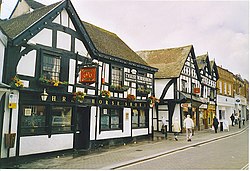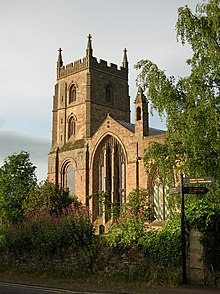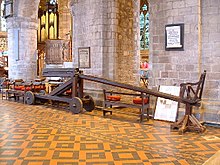Leominster
| Leominster | |
| Herefordshire | |
|---|---|
 The Three Horseshoes in Corn Square, Leominster | |
| Location | |
| Grid reference: | SO496591 |
| Location: | 52°13’42"N, 2°44’19"W |
| Data | |
| Population: | 11,100 (2009 estimate) |
| Post town: | Leominster |
| Postcode: | HR6 |
| Dialling code: | 01568 |
| Local Government | |
| Council: | Herefordshire |
| Parliamentary constituency: |
North Herefordshire |
Leominster (Welsh: Llanllieni) is a market town in Herefordshire. It is found about 12 miles north of Hereford and 11 miles south of Ludlow, at the meeting of the River Lugg and its tributary the River Kenwater.
Leominister is the second largest town in the county, with a population of some 11,000. [1]
Name of the town
The popular derivation of "Leominster" is from "Leofric's Minster", as Earl Leofric is said to have founded a monastery or minster here, though almost within Leofric's lifetime the |Anglo-Saxon Chronicle gives the names as "Leomynster"[2]
The name means either "dear (leof) minster" or Leon minster after an otherwise unknown placename which some have sought to dervice from a Welsh root lei to flow.[3]
The Welsh name for Leominster is Llanllieni.
History
According to the Anglo-Saxon Chronicle, in 1046 Swegn, son of Earl Godwin entered Leominster after a campaign amongst the Welsh and carried the Abbess off for his own purposes. In 1052, a raid by Gruffudd ap Llywelyn on Leominster resulted in the Battle of Llanllieni, at which his English opponents were supported by French auxiliaries manning a local castle.
The Domesday Book of 1086 states that Leominstre was the King's land and that it had belonged to Queen Edith.
King Henry II bestowed the minster and its estates on Reading Abbey, which founded a new priory at Leominster in 1121.[4] Its Priory Church of St Peter and St Paul now serves as the parish church; the only remaining part of the monastery.
The priory was ransacked by the forces of Owain Glyndŵr after his victory at the Battle of Bryn Glas near Pilleth in 1402, along with several local manor houses.
Investigations to the north of the priory in 2005 located the position of the cloister, although most of the stone had been removed following the dissolution during the Henrician Reformation. Discarded animal bones found on the site when submitted to carbon dating showed that the area was occupied in the 7th century, which agrees with the date of 660 AD associated with the founding myth, which suggests a Christian community was established here by a monk, St Ædfrið, from Northumbria.
Leominster is also the historical home of Ryeland sheep, a breed once famed for its "Lemster" wool, known as 'Lemster ore'. This wool was prized above all other English wool in trade with the continent of Europe in the Middle Ages. It was the income and prosperity from this wool trade that established the wealth of the town and the minster.
From approximately 1748 to 1754, Leominster was home to one of only four early cotton spinning mills employing the spinning machines of Lewis Paul and John Wyatt. The mill was financed by Lancashire native Daniel Bourn, and was partly owned by other men from Lancashire. Bourn introduced his own version of the carding engine to work at this mill, and of the four Paul-Wyatt mills, it may have been the most successful, as shortly after the fire that destroyed the mill, it was reported that the cotton works "had been viewed with great pleasure and admiration by travellers and all who had seen them."[5]
One of the last ordeals by ducking stool took place in Leominster in 1809, when Jenny Pipes was ducked. The ducking stool is on public display in the Church and a mechanised depiction of it is featured on the town clock.
Local attractions
- Croft Castle [1]
- Berrington Hall [2]
- Leominster Folk Museum [3]
- Broadfield Court
- Burford House Gardens
- The Priory Church, Leominster
- Lucton School
References
- ↑ Population estimates for LSOAs, wards & towns in Herefordshire, 2008 (XLS format)
- ↑ Leomynstre in the dative form: Abbingdon II Chronicle 1046, Peterborough Chronicle 1052
- ↑ J. & C. Hillaby, Leominster Minster, Priory, and Borough c.660-1539 (Logaston Press, Almeley, Herefs. 2006), 4-5.
- ↑ Hillaby, 53-7
- ↑ Manchester Mercury, reported on 5 November 1754

